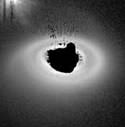
Image credit: Hubble
The new Advanced Camera for Surveys (ACS) on the Hubble Space Telescope has revealed a clear disk of dust around a young, 5 million year old star. Astronomers believe these disks are the birthplaces of planets. The star, called HD 141569A is part of a triple star system located 320 light-years away in the constellation of Libra.
NASA Hubble Space Telescope’s new Advanced Camera for Surveys (ACS) has given astronomers their clearest view yet of the dust disk around a young, 5-million-year-old star. Such disks are expected to be the birthplace of planets. The star, called HD 141569A, lies 320 light-years away in the constellation Libra and appears to be a member of a triple-star system.
The star HD 141569A was first identified as a candidate for a circumstellar disk in 1986, from observations done with the NASA/Netherlands/United Kingdom Infrared Astronomy Satellite (IRAS). An excess of infrared radiation associated with the star provides telltale evidence for the presence of a dust disk. Hubble’s Near Infrared Camera and Multi-Object Spectrometer photographed the disk in 1999 and revealed two concentric rings divided by a dark lane. This was interpreted as evidence of dynamical sculpting by one or more planets.
The ACS reveals that the disk’s structure is much more complex than previously thought. The disk is actually a tightly wound spiral structure. The outer regions of the disk reveal two diffuse spiral arms, one of which appears to be associated with the nearby double star system (HD 141569BC) seen at the upper left. The apparent connection between the disk and the double star suggest that an interaction with the double star may be responsible for the structures seen in the disk.
However, previous mid-IR images of the disk show that it is relatively clear of dust within approximately 2.8 billion miles of the star. This inner region may have been swept clear by one or more unseen planets.
These observations of the disk were obtained with the ACS’s High Resolution Camera (HRC) coronagraph. The photo on the left is a processed visible light image. In the photo on the right, the disk has been geometrically altered to simulate a face-on view, and false-color has been applied to enhance the disk structure. The black center marks regions where light from the star has been masked out. These images are the first results of a survey of disks around young main-sequence stars being conducted by the ACS science team.
Original Source: Hubble News Release
